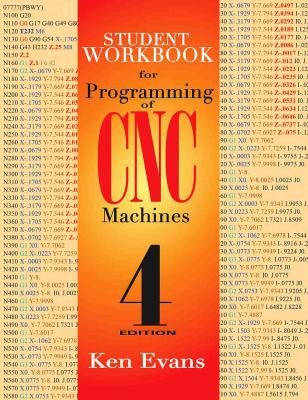ТОП просматриваемых книг сайта:
Student Workbook for Programming of CNC Machines. Ken Evans
Читать онлайн.Название Student Workbook for Programming of CNC Machines
Год выпуска 0
isbn 9780831193812
Автор произведения Ken Evans
Жанр Программы
Издательство Ingram
Figure 1-2 Machining Center Process Planning
In the example in Figure 1-2, it will be necessary to machine the part from a solid blank of Aluminum that is pre-machined to 4.25 square and is 1.25 thick. The top surface must have .125 inch of material removed as well. Dimensional tolerances are as follows: .X = plus or minus .015 inch, .XX = plus or minus .010 inch, .XXX = plus or minus .005 inch, and angular tolerance is plus or minus .5 degree. Please use the copies of the Process Planning sheets and develop a plan to machine the part to dimensional requirements. Make your tool selections from the CNC Machining Center Tool List found in Unit 4, CNC Machining Center Programming.
Feeds and Speeds
Charts 1-4 and 1-5 are supplied for use in answering the exercise problems presented here. The Surface Feet per Minute (SFPM) and Feed in inches per revolution (in/rev) values represented here are given in ranges. Note that the values starting at the low end of the range are intended as a minimum starting point for calculations; those at the high end are a maximum recommended SFPM and Feed. Final values used for machining may differ based on many factors. As you answer the problems, use values that are within the ranges given. Refer to Programming of CNC Machines (Part 1, CNC Basics, Metal Cutting Factors) for detailed information regarding Feed and Speed calculations. A more comprehensive source for machining data is the Machinery’s Handbook; other valuable sources for machining data are in the tool and insert catalogs and online applications supplied by cutting tool manufacturers.
Chart 1-4 Feeds and Speeds for Turning
| Tool Material | ||
| Material | High Speed Steel | Carbide |
| Carbon Steel Feed in/rev | 30–60.006–.012 | 200–1300.008–.036 |
| Alloy Steel Feed in/rev | 30–120.006–.012 | 125–1000.008–.036 |
| Stainless Steel Feed in/rev | 25–110.006–.012 | 80–945.007–.036 |
| Aluminum Feed in/rev | 500–800.006–.012 | 2800–4500.017–.036 |
Note: As a general rule, the minimum depth of cut should be 1.5 to 2 times the tool nose radius. The maximum feed rate should be approximately one half the tool nose radius for rough turning using carbide inserts.
For milling, the maximum depth of cut is equal to the flute length or the insert height and the maximum width of cut is the cutter diameter. However, these measures are not practical in most cases. A more widely used practice is to set the maximum depth of cut to 2/3 of the flute length and the maximum width of cut to 2/3 of the diameter, as well. These basic conditions should be followed for the remainder of this workbook. Drilling calculations should be based on High Speed Steel (HSS) values for Turning and HSS End Mill values for Milling.
Chart 1-5 Feeds and Speeds for Milling
| HSS End Mill | Carbide End Mill | Carbide Inserted Face Mill | |
| Carbon Steel Feed in/tooth | 25–140.001–.004 | 210–1000.006–.012 | 90–685.020–.039 |
| Alloy Steel Feed in/tooth | 5–85.001–.004 | 40–450.006–.012 | 39–475.020–.039 |
| Stainless Steel Feed in/tooth | 20–80.001–.003 | 200–700.006–.012 | 210–385.020–.039 |
| Aluminum Feed in/tooth | 165–850.002–.006 | 600–2000.008–.015 | 755–1720.020–.039 |
Refer to the following formula to calculate revolutions per minute (r/min).
where
CS = Cutting Speed from the charts above or the Machinery’s Handbook
π = 3.1417
D = Diameter of the workpiece or the cutter
Refer to the charts above or the Machinery’s Handbook for the feed in inches per tooth (in/tooth) for chip load recommendations. Also review the formula below to calculate the feed aspect of the metal-cutting operation.
F = R × N × f
where
F = Feed rate in inches per minute (in/min)
R = r/min calculated from the preceding formula
N = the number of cutting edges
f = the chip load, per tooth, recommended from the charts above or the Machinery’s Handbook
1. On a CNC lathe, a facing cut is needed to establish the part-zero surface. The alloy steel bar stock is 2.5 inches in diameter and has 1/32 inch of excess material to be removed from each side. A carbide-inserted tool with a 1/32 inch nose radius will be used for this operation. Because the diameter changes as the tool travels toward the centerline, what should the r/min be? What should the SFPM be? What should the depth of cut be?
2. When finish turning an aluminum bar that is 2.3125 inches in diameter with a carbide-inserted turning tool that has a 1/64 inch tool nose radius, what is the r/min and feed rate required if the depth of cut is 1/64 inch per side?
3. An internal threading operation is required on a CNC lathe to make a 1-8 UNC thread in a carbon steel part. The cutting tool material is High Speed Steel. What should the r/min be for this operation?
4. Calculate the appropriate speeds and feeds for each of the required tools in the lathe process planning project above and enter your answers on your CNC Setup sheet in the comments section.
5. Calculate the appropriate speeds and feeds for each of the required tools in the mill process planning project above and enter your

